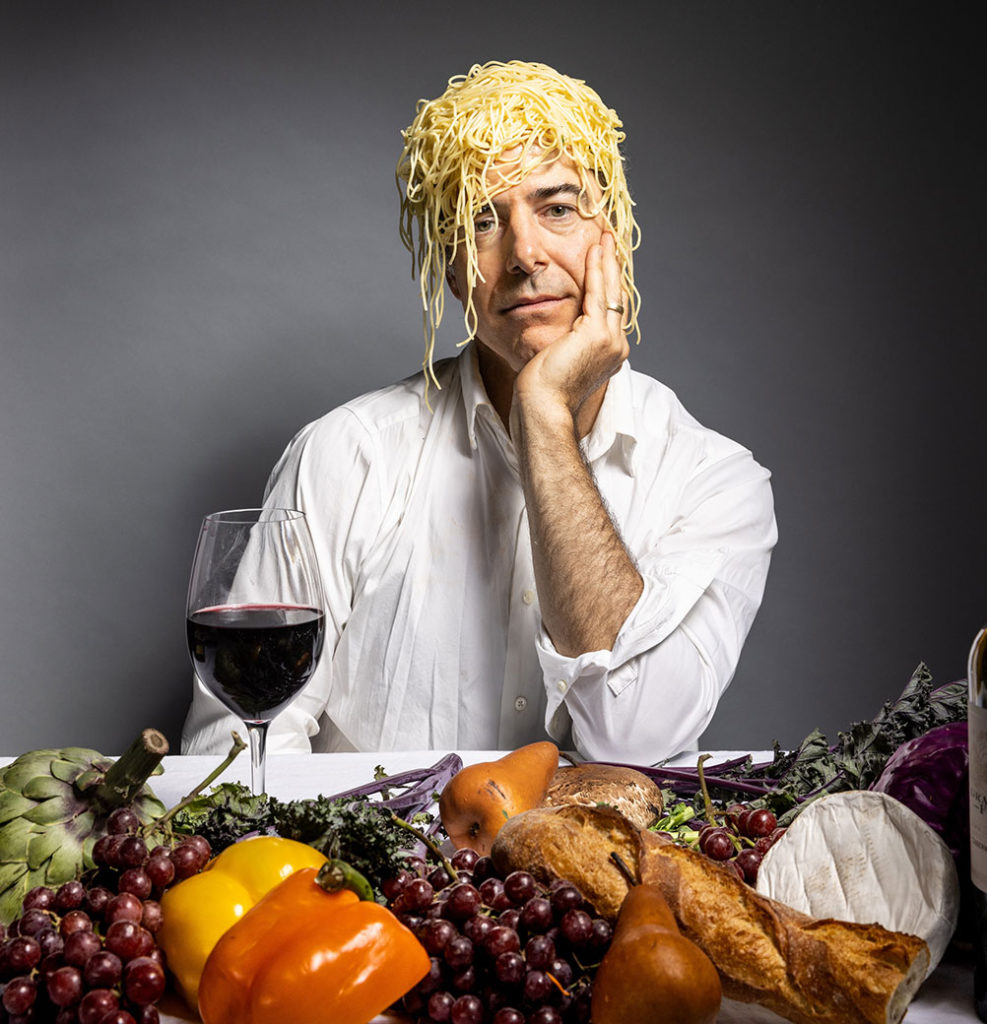Magician, actor and theatrical storyteller Geoff Sobelle resists revealing many of the secrets behind his latest creation, Food.
“The show changes all the time,” he says. “I can’t be explicit. People don’t need preparation to see Food. The show does all the education. They don’t need any history; they can just go.”
The show, which debuted in 2022 at the Philadelphia Fringe Festival, has built up enough word of mouth to fill Stanford University’s Memorial Auditorium for five shows from Feb. 5–8.
He asserts, “In a way, anything told ahead of time messes up the plot. The way these things are made is not to have clue sheets or help unlocking them. You should come in, let it wash over you, and see how it hits you.”
“These shows are a full show, but then there’s a conversation you’re left with to have in the bar afterwards,” he says.
In the roughly 80-minute live event, Sobelle explores how and what people eat—as well as the ways food is grown, sourced, manufactured, farmed, prepared, served and experienced individually or in community.
A phrase such as “who pays the bill” ranges from a small, literal question posed in a restaurant to an inquiry into the social and relationship implications of the true environmental or health “price” of certain foods—how much is sacrificed, forfeited or compromised by the eating of a burger or living in a culture of burgers.
Food is the third piece in a trilogy that includes The Object Lesson (2013) and Home (2017). Each show examines a kernel or core idea—things, dwelling or eating—and expands it to intriguing depth and wide emotional range through the use of illusion, film, magic, comedy, clown-based physical theater, mechanical inventions and improvisation.
Sobelle’s trilogy takes mundane corners of everyday life—eating, sleeping and the accumulation of objects—and spins them into provocative platforms that inform people about who they are, where they have been, and where society might be going.
Extensive dramaturgy, research and reflection are integral to Sobelle’s creative process—a fact made evident by the artist’s ability to build something monumental out of life’s almost-nothings, which people frequently take for granted.
Participatory Theater
It would not be surprising to find Sobelle joining a post-show recap session at a bar, because the cornerstone to the trilogy is his intense passion for people and coming together.
“I love being with people. They’re frustrating, terrifying, deeply saddening, exhilarating and complicated. That’s what this is all about. I don’t have any real wisdom to impart, but I love playing with people. I love when they laugh, breathe together, and the temperature in the room changes when they come together. It’s not radical. It’s what we always want. We went through a couple years of not being together or having to be together in small pods during the pandemic. It was tricky and we’re traumatized by that.”
In sports stadiums, churches, theaters, restaurants, bars, concert halls and other public venues, the urge to be together is overwhelming, irresistible and organic, he insists. “I actually think we go to see a musical or a show and think it’s the event that’s great. But it’s not the production; it’s the way it hit and shook their alchemy that made them feel so awesome.”
A Stanford alumnus, Sobelle recalls watching movies in Memorial Auditorium, the same theater in which his show will be presented by Stanford Live. Students would pile in to watch films, and there was rarely an empty seat. Sobelle remembers it was the shared audience energy, not the films, that made it a must-go activity.
Another primary element to Food and the other works in the trilogy is that audience members are both participants and observers. The Object Lesson performance-installation turned the theater space into a gargantuan warehouse. Surrounded by stacks of boxes and stuff, people are encouraged to open, touch, smell, use, rearrange, share and in other ways interact with the objects. All along, Sobelle performs acts of wizardry and wit, often engaging someone in the crowd as a collaborative partner.
The second work in the trilogy, Home, is architecturally stunning and moves within an open-wall structure comprising various rooms. The giant, two-story party house has audience members assisting in construction, home repair, taking baths, doing meal prep, moving furniture, turning electronics off and on and using them. They become an ensemble made up of individuals who arrive at the show as strangers and depart with a sense of family.
The setting for Food is more streamlined. At a single, large dinner table, people eat and drink wine next to, facing or at a distance from their dinner companions. The shows are designed most often around single-purpose spaces in which the real people inhabiting them watch, listen, interact and move genuinely together in harmonious and disharmonious ways.
“We come into this world as physical beings far before we’re speaking beings. We’re expressive from the first moments and even before emerging from the womb. I have two little kids, and how much they express before having speech and also how speech is a physical thing is real. It’s expository; you can rely on showing versus telling.
“I’m drawn to physical theater,” Sobelle continues. “I would prefer to watch five people waiting for the bus than five people sitting around a kitchen table arguing about politics. The two things might have the exact same theme. But personally, as an audience member, I like to be drawn in by something compelling, not told what it means. I like doing that work myself.”
Serving Up Ideas
Reaching to touch a person’s inner world through theater, Sobelle believes he is ministering, not serving up or representing characters within an explicit narrative or drama. “There’s no one story, no Aristotelian sense of structure. There’s a structure, but not an exact fictional story. I love playing with truth and believability. Those themes are fantastic, but I’m skeptical of the well-told story. There are people who do that really well and I love seeing that, but it’s not what I do.”

When Sobelle says there is a form of structure, the comment draws an obvious question: What are the tools and elements used to craft and sculpt the production? Two things, time and space, are the crucial priorities for consideration. “It’s fun to think about space and the materials in them and what they say to each other. I like one-purpose rooms: court rooms are for court proceedings, surgical amphitheaters for surgery. They’re also performative spaces, as are theaters, restaurants and any dining table. What’s the best way to be in a dining room together? Everyone sitting around one giant table. It’s important we’re all at the same table. We see one another. We’re watching each other and that becomes a part of the theater of dining. It’s a metaphor, but also a fun, entertaining motor the show uses to run on.
”Methods for compressing or stretching people’s sense of time achieve artistic purpose when they create mysterious moments in which time seems to disappear, slow, stop—or race ahead at breakneck speeds. Again, Sobelle resists getting too detailed or describing specific examples of Food’s time manipulations. According to him, it is best if people come in planning to attend a dinner theater and are “broadsided” by surprising, comic, everyday juxtapositions that land inconspicuously in the realization of eternally profound truths.
Theater and Magic
The magic Sobelle practices today has been developed and refined by training he undertook at the Lecoq school in Paris. He is a 14-year-plus member of Philadelphia’s Pig Iron Theater Company and has his own company, rainpan 43. But the less high-brow roots of his artistry find their origins in his childhood.
“As a kid, sleight-of-hand magic was the first thing I did totally on my own. I’d go with a magic book, coins, cards, and props I had to build. I made certain things to get chemical reactions or built contraptions as gimmicks. … Most magicians are like this. You spend hundreds of hours in front of the mirror practicing something, all for 30 seconds of performance. It’s a ridiculous amount of effort for a small amount of productivity.”
In an active way, Sobelle as a kid was teaching himself how to make stuff and what a theatrical moment is. “A moment of theater is a bit like a magic trick. It’s taking what the audience is aware of and not aware of. Magic deals with circumstance: there’s a given reality of what’s around you. A magician looks right at you, talks to you. It’s important everyone agrees on a given reality. The moment there’s story or you use magic in a play, it stops becoming magic and becomes more like a special effect. For me, theater’s not the suspension of disbelief, it’s provoking you with what’s real, but fooling you anyway.”
Food Matters
The challenge and rewards of his work, he insists, are world-building. Which makes one wonder if Food unrolls and speaks to audiences differently depending on the country and its culture, art, politics and other factors. Are these inherently American shows? Is Food adaptable and affective independent of where it is presented?
“I think so. I don’t see why it wouldn’t be because it’s about the people who are coming. It’s adaptable and thrilling to bring it to other cultures. I am American, so I’m aware of what I bring. I understand I have major blind spots, but I also get to see what we have in common.
“We recently brought Food to South Korea. The biggest thing was that there is one culture there that’s grown and done its thing for 2,000 years,” Sobelle relates. “There are one hundred different types of kimchi, for example, but you’re going to have kimchi at every meal. South Korea was one of the first places we’ve toured that did not have a colonial or immigrant-based diet, like what we have in America where food is all about cultural exchange.
“Food matters everywhere, but in Korea, asking “How ya doing” is said, “Did you eat today?” The ways of caring about each other in different countries are almost funny, because they’re so strong. That allows for comedy but also poetry. Everywhere we go, the experience is potent,” he sums up.
Having breached the barriers and rolling out some of the show’s bedrock elements during the 70-minute conversation, Sobelle returns to where it all began: Don’t prep, just come. Sit at the table, move and be moved, together.
Geoff Sobelle: Food runs Feb 5–8 at Memorial Auditorium on the Stanford University campus. The five performances are at capacity; sign up at live.stanford.edu/events to be notified about ticket releases.



